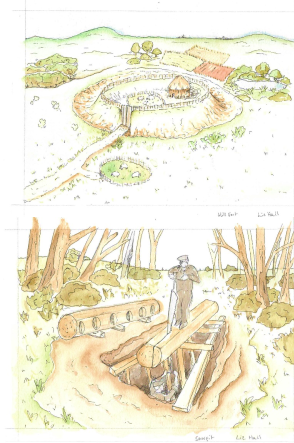‘grid_reference’:”,’shelf_mark’:’FF7 Map tank 3, formerly part of FF13-14-02′,’map_envelope’: ”,’map_category’: ”,’map_os_reference’: ‘SU 3000 3100′,’map_revision_date’: ”,’map_coverage’: ‘Setley, Royden Manor’,’map_quoted_scale’: ‘1:2,500′,’map_fractional_scale’: ‘[1:2,500]’,’edition’: ”,’comments’: ”,’map_annotated’: ”,’accession_number’: ”,’map_annotation_comment’: ”,’creator’: ‘Ordnance Survey’
Contributor: Kath Walker
The Commoners’ New Forest by F.E. Kenchington
Review by Peter Roberts
This book was written by Dr F.E. Kenchington, whose family roots were from the Forest and who had returned there whilst working for the County War Agricultural Committee; working on the ‘reclamation’ of Forest lawns and cultivation of the Forest wastes to reduce demands on foreign supplies of food stuffs.
The book was first published by Hutchinson & Co. Ltd. in 1944, with reprints in 1945 and 1949, but apparently finished at the end of 1942 as indicated by a date at the end of the final chapter.
Although Kenchington was new to the area, his family connections gave him a way into the often closed community of the commoners and his writing reflects his respect for their way of life. His background as a scientific agriculturist, an ‘improver’, he, like Cobbett, saw much of the Forest as wasteland, though, in balance, was not so one-sided to avoid the phrase ‘rape-of-the-earth mono-crop exploitations’. Indeed, he clearly felt affinity with the Forest way of life whilst also looking to use his scientific expertise to the benefit of the commoners’ New Forest.
On his arrival in the Forest Kenchington noted that the existing literature was often derivative of one or two major works, aimed at the day tripper or incomer and concerned such attraction as might be of interest to them. As such, the consideration of the local system of agriculture had been largely overlooked; indeed the commoners stock gained more coverage than the stock of commoners behind them. With this in mind Kenchington sought to redress the balance and write a history of the area from an agricultural perspective together with the political background of the area’s more recent history.
It was, however, more than this; it is written with the characteristic viewpoint of the time, a viewpoint which became embedded in the agriculture of the 1950s where man overcame nature rather than working with it. Its glance to the future clearly identified the same, though in a positive light which, with the benefit of hindsight, was clearly a time when the great losses of those things we now value about the countryside occurred. This very viewpoint makes it a valuable social record of the time, and its interpretation of past events also reflects the same. Historically, it is subject to the same oft repeated inaccuracies of many books of its time but the nearer one approaches the time of writing the more it captures the feeling of the period. Rounding up, it is an important social record of the New Forest, at a particular time from a particular viewpoint, and well worthy of a place in any collection of Forest books.
The Lymington Laundry
‘description’:’The Lymington Laundry, opposite the town quay. This was originally built as a theatre and place of entertainment. The laundry had many rows of washing lines at the rear to dry the clothing. There were approximately 50 employees. In later times the site was used as an engineering works.’,’colour’: ‘B & W’,’publisher’: ‘n/a’,’creator’:’Simmons, Arthur George’,’place_of_publication’: ‘Unpublished’,’format’: ”,’accession_number’: ”,’image_location’: ‘The Lymington Laundry’,’object_number’:’COMP4.009.053′
The New Forest by Colin R. Tubbs
Review by Peter Roberts
The New Forest by Colin Tubbs is fully entitled The New Forest, History, Ecology & Conservation and was published posthumously by the New Forest Ninth Centenary Trust in 2001 after the manuscript had been finished by his widow Jennifer. Colin had died in October 1997.
It is a masterly bringing together of all aspects of the New Forest in relation to the habitats and wildlife it contains. Colin fully understood the complex relationships between these features and they are covered in generous detail throughout the pages of this volume.
The book is, in reality, a re-written and updated version of two other books by Colin Tubbs. These were The New Forest: An Ecological History published by David & Charles in 1968 and The New Forest: A Natural History published by Collins in 1986, both as a soft-back and also as a hard-back in the highly regarded New Naturalist Series. The latter version has proved very popular amongst collectors and interested persons alike and many of the soft-back issues were retained and rebound as hard-backs.
Despite Colin’s training as an ecologist he also recognised and thoroughly understood the archaeological and historical background to the Forest and, therefore, the changes in management regimes and other factors which have remained more or less constant; indeed, a large proportion of the book considers this background as the Forest is a rare survival of a once common pastoral landscape.
The chapters concerning wildlife are based around habitat types, but never far away is reference to how these relate to the other habitats which form the Forest mosaic. Individual species are considered in relation to these habitats and how they utilise and shape the environment in which they live is explained. There is emphasis on species which indicate the importance of the Forest or explain certain ecological principles.
All in all, the book demonstrates why the Forest is such a rare survival in lowland Europe today and therefore why it is so rich in rare wildlife today.
The New Forest Register of Decisions of Claims to Forest Rights
A Review by Peter Roberts
The New Forest Register of Decisions of Claims to Forest Rights published in 1858 is the handbook of who is entitled to what on the New Forest. In many commoning families it is regarded as the ‘bible’ of the Forest. Following inquries into the management of all the Royal Forests a decade earlier it was decided that updating the register of claims would be an important part of valuing the New Forest. The 1848 inquiry concluded that a separation of commoners rights from crown rights would be of advantage to the crown. The deer would be removed and more land could be set aside for timber plantations.
The book was one of the famous government ‘blue books’ printed by Eyre and Spottiswood for Her Majesty’s Stationery Office. The Eyre was George Eyre a member of the family still resident in Bramshaw who have been active for many generations in Forest affairs. One thousand three hundred and eleven claims are listed in the book, all are shown as either amended or disallowed. Apart from the claim number they give name, address and occupation of the claimant, the date the decision was made, the nature of the claim as amended and the size and location of the lands to which they refer.
The claims are for common of pasture, turbary, mast, fuel wood, sheep and marl. The first is the most important today allowing the successful claimant to depasture ponies, donkeys or cattle on the Forest.
| Right | Allowed |
| Pasture | Ponies, Donkeys, Cattle |
| Turbary | Cutting turf for burning |
| Mast | Pigs to eat acorns in the autumn |
| Fuel wood | Wood for burning |
| Sheep | Sheep pasture, rare |
| Marl | Clay like fertilizer |
The claim here by Joseph Short, Lyndhurst’s grocer, for tithe areas 209 and 177 cover the land now occupied by the car park and New Forest Centre. It looks as if the Centre could run ponies and pigs on the Forest for the right goes with occupancy of land and not the individual. This is also a reminder that for most people commoning was part of their way of life but not the only means by which they earned a living.
This book provides the basis for modern day claims although for ease of use the tithe numbers in the claims book have been transferred to an Atlas, a copy of which is held by the Verderers’ Clerk in Lyndhurst
The New Forest: its History and Scenery by John Wise
Review by Peter Roberts
John Wise’s ‘The New Forest: its History and Scenery’ was first published in 1863. It ran to five editions with a number of variations in the 19th century together with a reprint in the 20th. It remains a standard work because he captured an understanding of the area by his own observations and enquiries together with enlisting help from many local specialists.
During the previous year he had toured the Forest with the young Walter Crane who provided 63 illustrations; neither were New Forest men. Something of a literary Gypsy, Wise was born to a well-to-do Devon family but lost his parents early. He was educated at Grantham School and Oxford University but left without a degree to further his passion for travel, ornithology and writing. He became deeply interested in many aspects of the natural world and developed a love for words. He contributed to the Westminster Review and Cornhill magazines before publishing a slim volume of poems entitled Robin Hood.
In The New Forest he provided an overview of the history and archaeology together with a guide to the villages and ‘wild’ places within the New Forest. His knowledge and evident love of the area for its own sake helped bring about a better understanding of how everybody could benefit from it.
“But in its wild scenery lies its greatest charm. From every hill-top gleam the blue waters of the English Channel… Nowhere, in extent at least, spread such stretches of heath and moor, golden in the spring with the blaze of ferns, and in the autumn purple with heather, and bronzed with the fading fern. Nowhere in England rise such oak-woods, their boughs rimed with the frostwork of lichens, and dark beech-groves with their floor of red brown leaves, on which the branches weave their own creative warp and woof of light and shade.”
In 1881 Wise came into some money by the death of his uncle Henry Ellison. It is probably not a co-incidence that a fourth edition of his by now famous work appeared. The Artist’s Edition, which incorporated the original 63 Crane illustrations, was further enhanced with 12 etchings by artist and archaeologist Heywood Sumner. The books were finely bound in birch and produced in a numbered, limited edition of 350. A further 50 were also produced in a slightly larger format and again bound in birch; both were published in 1883.
Further travels included living in Yorkshire and Edwinstow on the edge of Sherwood Forest before he returned to the New Forest in the autumn of 1889. He suffered illness at his boarding house, South View in Gosport Road, Lyndhurst and died there on 1st April 1890. He is buried close to the gate of the cemetery beyond Bolton’s Bench in the New Forest he came to love.
In the preface to the Artist’s Edition of August, 1882 he concluded:
“We may indeed rejoice that Epping Forest has lately been bought as a park for the people of London, but we should rejoice still more that the New Forest requires not to be purchased… but that it remains, not indeed now the hunting-ground of a king, but the park of the nation.”
The Real Alice by Anne Clark
Review by Peter Roberts
‘The Real Alice’ is a major biography of Alice Liddell, the girl who was immortalised in Lewis Carroll’s famous stories married Reginald Hargreaves and spent more than fifty years living at Cuffnells in Lyndhurst.
Anne Clarke, a founder member of the Lewis Carroll Society, published a biography of Carroll in 1979 two years before this work. Naturally much of this book is concerned with the young Alice and her relationship with Charles Dodgson (Lewis Carroll) at Christ Church, Oxford.
However the book also provides an insight not only into the life of Alice Hargreaves but also Forest society through a period when immense changes were taking place in land holdings and the social structure. The depression of the last quarter of the 19th century coincided with Alice’s arrival in Lyndhurst. Jonathan and Anna Hargreaves bought Cuffnells from Sir Edward Poore in 1856. Their son Reginald went up to Oxford in 1876 where he and Alice formed a friendship which evolved into an engagement and marriage.
Neither of Reginald’s parents survived long enough to meet their new daughter-in-law. Thus Alice and Reginald came to Lyndhurst to a large estate with the finest house in Lyndhurst as their home. Cuffnells has been a substantial farmhouse in the 17th century and was greatly expanded in the 18th by the politician George Rose to become one of the finest house in the county. He received visits from George III on a number of occasions.
Alice and Reginald had three children, all boys, born in the 1880s. The family enjoyed country pursuits; Reginald was a keen and competent sportsman and took the part of the country gentleman as a magistrate and on the parish council. Alice however, although playing a part in village affairs, had great sadness early in her life. Her sister, Edith, died of peritonitis aged just 22 in 1876. This tragedy was followed by the death of Prince Leopold, son of Queen Victoria, a close friend in 1884.
The First World War brought fresh tragedy for Alice and Reginald with the deaths of their first two sons. Caryl, the youngest, was recalled and never had to experience that war again. There are plaques to both of them in St Michael’s Church, Lyndhurst and a stained glass window in Emery Down. Reginald died in 1926, the final devastating blow for Alice. The estate was inherited by Caryl and she spent her final years between Cuffnells and a house in Kent, Westerham. She died in 1934 and is buried in an unpretentious grave in the churchyard at Lyndhurst.
Thirty-Five Years in the New Forest by Gerald Lascelles
Thirty-Five Years in the New Forest was first published in 1915, the year after Lascelles’s retirement as Deputy Surveyor. He had prevailed over the New Forest as the Crown’s chief officer during a difficult time which had included numerous clashes with the Verderers and the recently formed conservationist group the New Forest Association. His book provides an insight into the varied duties that he had to perform on behalf of his bosses in Whitehall, the Commissioners of Woods.
Lascelles was the second Deputy Surveyor to live at Queen’s House in Lyndhurst and was thus never far from the job in hand. Although he had a number of trusted assistants he liked to ride out early in the mornings, unannounced, and see for himself the work that was being done. He looked after his employees by improving the standard of their accommodation with the aid of his deputy John Roberts, a trained architect.
A keen sportsman and author, he wrote the articles on Sport in the New Forest and, with J Nisbet, Forestry and the New Forest in the Hampshire section of the Victoria County History as well as a number of other, mostly sporting, works notably The Art of Falconry of which he was a master.
He was perhaps the last of what may be termed the truly amateur land managers of the New Forest before the professionalism that came with the introduction of the Forestry Commission in the 1920s. He was the third son of the earl of Harewood and would thus have seen how a large estate was managed. His appointment followed the introduction of the 1877 New Forest Act which changed the priorities in land management away from the timber growing which had been the crown’s chief pre-occupation in the preceding 300 years.
He succeeded Lawrence Cumberbatch who had been forced to leave the job suffering from a nervous condition, something that was to impair Lascelles’s health towards the end of his term in office. He found it hard to accept the new role of the Verderers and a number of the comments in the book may be seen as ‘getting his own back’ for the difficulties he had had to work under. That apart it provides a unique insight into the working of the Forest during and immediately after a fascinating period. It is intriguing to read of the condition he found the Forest in on his appointment ‘Everything was in a state of chaos…’ He also admitted that when he was appointed he had never heard of the “New Forest Question”. This seems quite astonishing for the question of what to do with the area had persisted since the revelations of the 1848 inquiry which had shown the management fraud that had taken place. For the succeeding quarter of a century it had been assumed by many that the New Forest would either be utilised by the military or built over if it was not to become an exclusive crown timber unit.
However he set to, reading the various official reports back to the fifth report of 1789: ‘No one… should fail to study this most excellent and comprehensive report.’ Although his book has sections on his various interests and the conflicts within the New Forest the only visitors it mentions are royal ones. He does however understand that ‘the great and increasing interest now taken in the amenities of the New Forest by the public… will ultimately – even now has – become the dominant feature of the whole question.’
Two boys eating breakfast, camping, Hastings, June 1922..
‘description’:’Two boys eating breakfast, camping, Hastings, June 1922′,’colour’: ‘B & W’,’publisher’: ‘n/a’,’creator’:’Simmons, Arthur George’,’place_of_publication’: ‘Unpublished’,’format’: ”,’accession_number’: ”,’image_location’: ‘Hastings’,’object_number’:’COMP4.009.109′
University of Southampton Excel Internship Programme, 2016
In the summer of 2016, we were lucky enough to have an Intern work with us from the Excel Southampton Internship Programme at the University of Southampton.
Liz Hall came to work with us for a month during August as a Graphic Design and Illustration intern. She has written a blog post about her experience with us which you can read here…
Having graduated from The University of Southampton this summer, I was lucky enough to gain a placement based at the New Forest Centre in Lyndhurst. I worked with the New Forest Knowledge’ project, which is one of a variety of projects that are part of the ‘Our Past, Our Future’ landscape partnership scheme. This project is focused on digitising the collections of information and material held about The New Forest in order to make this accessible online to a wide audience of viewers from many different backgrounds and professions. The majority of my time was spent on the drawing and design of a new logo for the New Forest Knowledge project, producing illustrative documents to ensure the continuity of the project’s visual identity and other creative tasks that cropped up along the way.
Logo

As a Graphic design, Illustrator, and Photographer Intern and otherwise all-purpose creative person for the project, my main priority was to get the ball rolling on how the new logo might look.
Working from predefined boundaries and guides of what I needed to incorporate into the design, I came up with a variety of different possibilities. In discussion with the team, the design below was picked as our initial favourite.
This idea incorporates multiple thoughts we had about how the logo should look, and we felt it may present a more modern and academic focus.

The design still uses the integral tree visual, used in the New Forest Centre logo, as the basis of the design; however, these branches shape themselves into the form of a brain. This uses some of the desired themes we aimed to illustrate within the logo design involving knowledge and learning as well as nature. The graphic itself has the potential to be eye-catching and thought provoking, whilst still maintaining a classic and simple aesthetic.
I created different variations of this design, seen below. The version below left shows a thicker more rounded design of the ‘brain tree’ which is perhaps a bolder and more defined variation of the original version. I also drafted a version that included horses, to show a closer link to the original New Forest Centre logo. A final design will be produced following discussion with the rest of the team.

Display cabinet
Using the currently preferred draft for the logo design, I created a graphic to be used for the new display, aiming to inform and explain to the public what the project is about.
The graphic aims to catch the eye of passers-by and spark their interest, bringing them in to read and learn about the project. The words emerging from the roots (Share, Research, Future, Community, Preserve, Heritage, Nature, Inspire) are key aims and aspects of the project, and will correspond to other materials included in the display.
Illustration

I also spent a week working with members of the New Forest Knowledge team at The National Park Authority in Lymington. The work carried out here was to be used both on the New Forest Knowledge website and for a booklet, giving information on important archaeological sites and showing how and why it is important to preserve and maintain these monuments.
I created simple, understandable watercolour and ink illustrations to show the most common sites that occur in and around The New Forest. These illustrations show reconstructions of the archaeological sites and how they might have looked when they were in use. The hope is that in viewing these reconstructions it will enable people to visualise their initial appearance and therefore understand the importance of the sites in question.
The Centre has been a great environment to work in. Working mainly in the Christopher Tower New Forest Reference library, I have been surrounded by information both old and new, and by colleagues and volunteers who are excited and knowledgeable about the work that is happening and that lies ahead with this project. The wonderful team both at the New Forest Centre and The New Forest Park Authority offices have made me feel very welcome, and it has been a pleasure to work alongside such an enthusiastic and friendly group of people.

